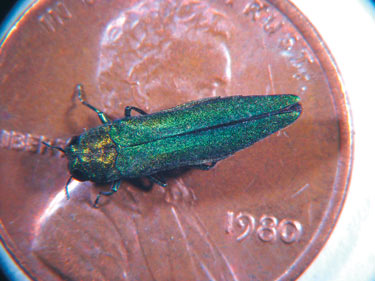
Emerald Ash Borer Found Just Outside Blue Line
Thursday, September 7, 2017
By: Rocci Aguirre - Adirondack Council Director of Conservation
During the last week of August the St. Regis Mohawk Tribe alerted the region to the discovery of emerald ash borer (EAB) on tribal lands in northern Franklin County just outside the Adirondack Park.
Black ash (a swamp species) is highly prized for basket-making by many northeastern tribes. Old reports dating back to the 1820’s (including one by Gifford Pinchot) on forests of the west-central Adirondacks, suggest that black ash was far more common then than it is currently. The emerald ash borer could now be the death knell for the species throughout its range.

The emerald ash borer has more effective dispersal than any invasive forest insect we’ve yet had to face, and attacks all of the ash species in our region (white, black, and green ash). And there is not yet strong evidence that any individuals of particular ash species have immunity. Unlike the hemlock wooly adelgid, whose northern range limit is currently restricted by cold winter temperatures, the climatic range of the ash borer includes all of northeastern North America.
Dutch elm disease virtually eliminated American elm from its preferred habitat (forested swamps), but elms also occur as isolated trees in upland forests, and the beetle that spreads the disease isn’t 100% successful at finding those isolated trees, so elms have persisted (at low numbers). But black ash is really only found in swamps, and given the dispersal ability of the emerald ash borer, the situation is bleak.
There were extensive (and expensive) efforts to control and eradicate the insect when it was first discovered in the Midwest 15 years ago, but those efforts were abandoned when it became clear they could not be successful. Bans on moving firewood are probably the most important tool currently in place. There are several very active research groups looking into ways to slow the spread of the insect while a biological control can be developed. But there is nowhere near the necessary funding available to get the work done in time given how rapidly the insect is spreading.
Although not unexpected, this is the first confirmed infestation of EAB in the Adirondack PRISM.
For more information: Adirondack Invasive Plant Program
To add your own invasive observations: iMapInvasives
Special thanks to Charles D. Canham, Ph.D. for sharing his expertise concerning forest invasives.
|
Would you like to comment on what you've read or viewed? We'd love to hear from you. Please click to send us a message.
|
||

 Rocci joined the Adirondack Council staff in 2013 as Director of Conservation. He is responsible for the design and implementation of the Council's conservation strategy. Rocci holds a MS in Resource Management and Conservation from Antioch University New England.Rocci’s previous work experience includes eight years spent as a ranger with the National Park Service, as field staff for Trout Unlimited and in the Catskills. overseeing land protection efforts for the Finger Lakes Land Trust in Ithaca, NY and the Monadnock Conservancy in Keene, NH. When not fly fishing or hunting, Rocci can usually be found hiking in the woods looking for chanterelles or other delicious ingredients to add to the supper pot.
Rocci joined the Adirondack Council staff in 2013 as Director of Conservation. He is responsible for the design and implementation of the Council's conservation strategy. Rocci holds a MS in Resource Management and Conservation from Antioch University New England.Rocci’s previous work experience includes eight years spent as a ranger with the National Park Service, as field staff for Trout Unlimited and in the Catskills. overseeing land protection efforts for the Finger Lakes Land Trust in Ithaca, NY and the Monadnock Conservancy in Keene, NH. When not fly fishing or hunting, Rocci can usually be found hiking in the woods looking for chanterelles or other delicious ingredients to add to the supper pot.


